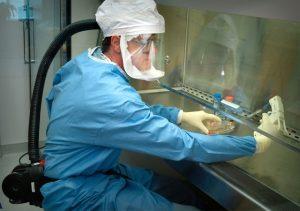-
10 Essential Facts You Need to Know About Sentinel Lymph Node Surgery
-
1. Definition and Purpose: Sentinel Lymph Node Surgery Identifies Cancer Spread
-
2. Minimally Invasive Compared to Traditional Lymph Node Dissection
-
7. Procedure May Involve Blue Dye, Radioactive Substances, or Both
-
8. Post-Surgery Pathology Determines Next Steps in Treatment
-
-
Is sentinel lymph node surgery a common procedure for cancer treatment?
-
What are the benefits of using a tracer substance during sentinel lymph node surgery?
-
How long does it typically take to recover from sentinel lymph node surgery?
-
Who might not be suitable candidates for undergoing sentinel lymph node surgery?
-
Discover essential insights into sentinel lymph node surgery, from its significance in cancer treatment to the recovery process and potential risks. Learn about the procedure’s benefits, such as improved accuracy and reduced side effects, making it a game-changer in modern medicine. Understand how this innovative approach enhances patient outcomes and quality of life post-surgery.

Explore our top picks for sentinel lymph node surgery procedures, each offering unique advantages tailored to individual needs. From cutting-edge technologies to renowned medical professionals specializing in this field, we’ve got you covered with comprehensive reviews that will guide your decision-making process effectively.
1. Definition and Purpose: Sentinel Lymph Node Surgery Identifies Cancer Spread
Sentinel lymph node surgery is a vital procedure used to pinpoint the initial lymph nodes where cancer cells are likely to spread. By identifying these sentinel lymph nodes, medical professionals can determine the extent of cancer spread more accurately.
This surgical technique is particularly crucial in staging various types of cancers, such as breast cancer and melanoma. Knowing whether cancer has reached the sentinel lymph nodes helps oncologists plan appropriate treatments effectively.
For instance, in breast cancer cases, if no cancer cells are found in the sentinel lymph nodes during surgery, it indicates a lower risk of metastasis and may influence decisions regarding further treatment like chemotherapy or radiation therapy.
In melanoma cases, identifying affected sentinel lymph nodes allows doctors to tailor interventions based on how far the disease has progressed. This precision aids in providing personalized care that targets specific areas at risk of spreading.
2. Minimally Invasive Compared to Traditional Lymph Node Dissection
Sentinel lymph node surgery stands out for its minimally invasive approach when compared to traditional lymph node dissection methods. This modern technique involves smaller incisions, reducing the trauma to surrounding tissues during the procedure.
Patients undergoing sentinel lymph node surgery experience a lower risk of complications post-operation due to the targeted removal of only specific nodes rather than many lymph nodes in a broader area. The precision afforded by this method contributes significantly to improved patient outcomes.
Furthermore, the minimally invasive nature of this surgery translates into faster recovery times for individuals. Patients can expect reduced pain and discomfort following the procedure, allowing them to resume their daily activities sooner than with more extensive surgeries like axillary dissection.
Overall, opting for sentinel lymph node surgery over traditional approaches not only ensures a less intrusive operation but also promotes quicker healing and minimal disruption to patients’ lives in their journey towards recovery.
3. Utilizes a Tracer Substance to Locate Sentinel Nodes
During sentinel lymph node surgery, a tracer substance plays a crucial role in locating the sentinel nodes. This substance is typically either a blue dye or a radioactive material that is injected near the tumor site, allowing for precise tracking.
By utilizing this tracer substance, surgeons can effectively follow its path through the lymphatic vessels and identify the sentinel nodes accurately. Once located, these nodes are carefully removed for further examination to determine if any cancer cells have spread to them.
This technique of using tracers enhances the precision of identifying and extracting specific nodes without unnecessary removal of non-affected ones. The accuracy provided by this method aids in reducing potential complications and ensures thorough evaluation of possible metastasis in these key nodes.
4. Key in Breast Cancer and Melanoma Treatments
Sentinel lymph node surgery plays a crucial role in the treatment of breast cancer and melanoma. In cases of breast cancer, this procedure is instrumental in determining whether cancer cells have spread to nearby lymph nodes from the primary tumor. This information is vital for staging breast cancer accurately.
For individuals with melanoma, sentinel lymph node surgery helps identify any potential spread (metastasis) of cancer cells to regional lymph nodes. This early detection can significantly impact treatment decisions and overall prognosis for patients with melanoma.
5. Potential for Fewer Side Effects, Such as Lymphedema
Sentinel lymph node surgery offers a significant advantage over traditional methods due to its potential to reduce side effects. Patients undergoing this procedure have a lower likelihood of developing lymphedema, which is characterized by swelling caused by disrupted lymphatic fluid drainage.
By specifically targeting the sentinel nodes rather than removing healthy lymph nodes unnecessarily, the risk of complications such as lymphedema is notably minimized. This precise approach helps in preserving the natural flow of lymphatic fluid and reduces disturbances in critical areas like the armpit (axilla).
This focused technique not only lowers the chances of post-operative issues but also enhances patient outcomes by preventing unnecessary trauma to unaffected regions like fat pads or surrounding tissues.
6. High Accuracy Rate in Detecting Cancer Cells
Sentinel lymph node surgery boasts a remarkable accuracy rate. By pinpointing the specific lymph nodes most likely to harbor these malignant cells, this surgical technique enables healthcare professionals to make informed decisions regarding further treatment options.
The precision offered by sentinel lymph node surgery plays a pivotal role in guiding subsequent medical interventions. With the ability to accurately identify areas where cancer is present, doctors can tailor treatments more effectively, leading to improved outcomes for patients undergoing these procedures.
This high level of accuracy not only aids in the early detection of cancer but also contributes significantly to enhancing patient care and prognosis post-surgery. By targeting the exact locations where cancerous cells are situated, medical teams can streamline treatment plans and increase the chances of successful recovery for individuals battling this disease.

7. Procedure May Involve Blue Dye, Radioactive Substances, or Both
The sentinel lymph node surgery procedure utilizes blue dye, radioactive substances, or a combination of both to locate the sentinel nodes effectively.
-
Blue dye is injected near the tumor site to help surgeons visualize and trace the lymphatic drainage pathway during the operation.
-
On the other hand, radioactive substances are employed to track the flow of lymphatic fluid in real-time and identify these crucial nodes accurately.
This dual approach enhances precision during surgery by providing visual and functional guidance for identifying and removing specific lymph nodes related to cancer spread.
8. Post-Surgery Pathology Determines Next Steps in Treatment
The pathology analysis of sentinel nodes post-surgery plays a crucial role in shaping the subsequent treatment plan for patients. Here’s how it impacts the course of action:
-
Negative Results: Absence of cancer cells in the sentinel nodes may indicate that further lymph node dissection is unnecessary, reducing the risk of complications associated with additional surgery.
-
Positive Results: Detection of cancer cells in these nodes can prompt recommendations for additional treatments like chemotherapy or radiation therapy to address any potential spread beyond the primary tumor site.
This meticulous examination by pathologists helps guide surgeons and oncologists in tailoring personalized treatment strategies based on each patient’s unique condition. It underscores the significance of precision and accuracy in determining the most effective interventions to enhance overall survival rates and reduce risks of regional recurrence.
9. Short Recovery Time with Minimal Scarring
Sentinel lymph node surgery stands out for its quick recovery period in contrast to traditional lymph node dissection methods. The procedure involves small incisions, leading to lesser tissue damage and a reduced healing time.
Patients undergoing this minimally invasive approach often benefit from minimal scarring due to the smaller incisions made during the surgery. This aspect not only contributes to cosmetic satisfaction but also aids in faster post-operative recovery.
The ability of sentinel lymph node surgery to minimize trauma to surrounding tissues results in less swelling, pain, and discomfort post-operation. As a consequence, individuals can return to their daily routines sooner than with conventional surgeries that involve larger incisions and more extensive tissue manipulation.
This surgical technique’s emphasis on precision helps reduce the risk of complications such as nerve injury or excessive scar tissue formation around the incision sites. Overall, the combination of small incisions and targeted removal of specific nodes enhances patient outcomes by promoting quicker healing times and reducing potential side effects associated with more invasive procedures.
10. Not Suitable for All Cancer Types or Stages
-
Eligibility Factors: The suitability of sentinel lymph node surgery varies based on factors like tumor size, location, and cancer type.
-
Comprehensive Evaluation: A thorough assessment by medical professionals is crucial to determine if a patient qualifies for this surgical procedure.
While sentinel lymph node surgery is an effective technique in certain cases, it’s essential to understand that not all cancer types or stages are suitable for this approach. The decision to undergo this surgery hinges on various aspects unique to each individual case.
It’s imperative that the care team evaluates the specific characteristics of the tumor and considers the overall health status of the patient before recommending sentinel lymph node surgery. This personalized approach ensures that patients receive treatment tailored to their needs and circumstances.
Summary
You’ve now learned about sentinel lymph node surgery, a minimally invasive procedure crucial in identifying cancer spread, especially in breast cancer and melanoma cases. By using tracer substances to locate sentinel nodes, this surgery boasts high accuracy rates in detecting cancer cells while potentially reducing side effects like lymphedema. Post-surgery pathology plays a vital role in determining the subsequent treatment steps, ensuring a short recovery time with minimal scarring. Remember, this procedure is not suitable for all cancer types or stages, so consult your healthcare provider for personalized advice.
Take charge of your health by staying informed and discussing all available options with your medical team. Your proactive approach can lead to better outcomes and a smoother journey through treatment. Stay empowered and advocate for the care that best suits your needs and circumstances.
Frequently Asked Questions
Is sentinel lymph node surgery a common procedure for cancer treatment?
Sentinel lymph node surgery is a widely used procedure in cancer treatment, especially for breast cancer and melanoma. It helps identify the spread of cancer cells to nearby lymph nodes accurately.

What are the benefits of using a tracer substance during sentinel lymph node surgery?
The use of a tracer substance helps locate the sentinel nodes with precision, aiding in identifying potential cancer spread. This minimally invasive technique reduces the risk of complications and ensures accurate results.
Are there any significant differences between traditional lymph node dissection and sentinel lymph node surgery?
Compared to traditional lymph node dissection, which involves removing multiple nodes, sentinel lymph node surgery is minimally invasive. It targets specific nodes where cancer is likely to spread first, reducing side effects like lymphedema.
How long does it typically take to recover from sentinel lymph node surgery?
Patients undergoing sentinel lymph node surgery can expect a shorter recovery time compared to traditional surgeries. With minimal scarring and fewer side effects, most individuals resume their daily activities within a few weeks post-surgery.
Who might not be suitable candidates for undergoing sentinel lymph node surgery?
While effective for certain cancers like breast cancer and melanoma, this procedure may not be suitable for all types or stages of cancer. Your healthcare provider will determine if you are an appropriate candidate based on individual factors.
